MARIANI’S
Virtual Gourmet
May
21, 2017
NEWSLETTER
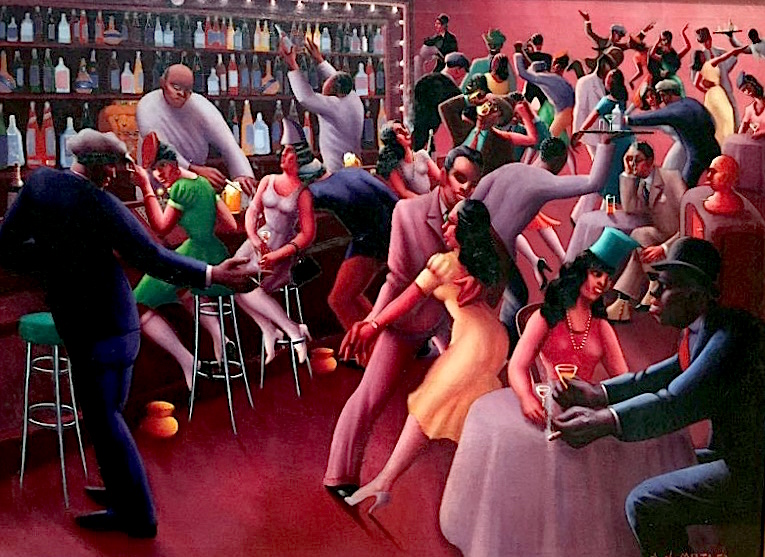
❖❖❖
IN THIS ISSUE
TWO FACES OF BARCELONA CUISINE
By Gerry Dawes
NEW YORK CORNER
IL GATTOPARDO and
MOZZARELLA E VINO
By John Mariani
NOTES FROM THE WINE CELLAR
By John Mariani
❖❖
TWO FACES OF
BARCELONA CUISINE
By Gerry Dawes
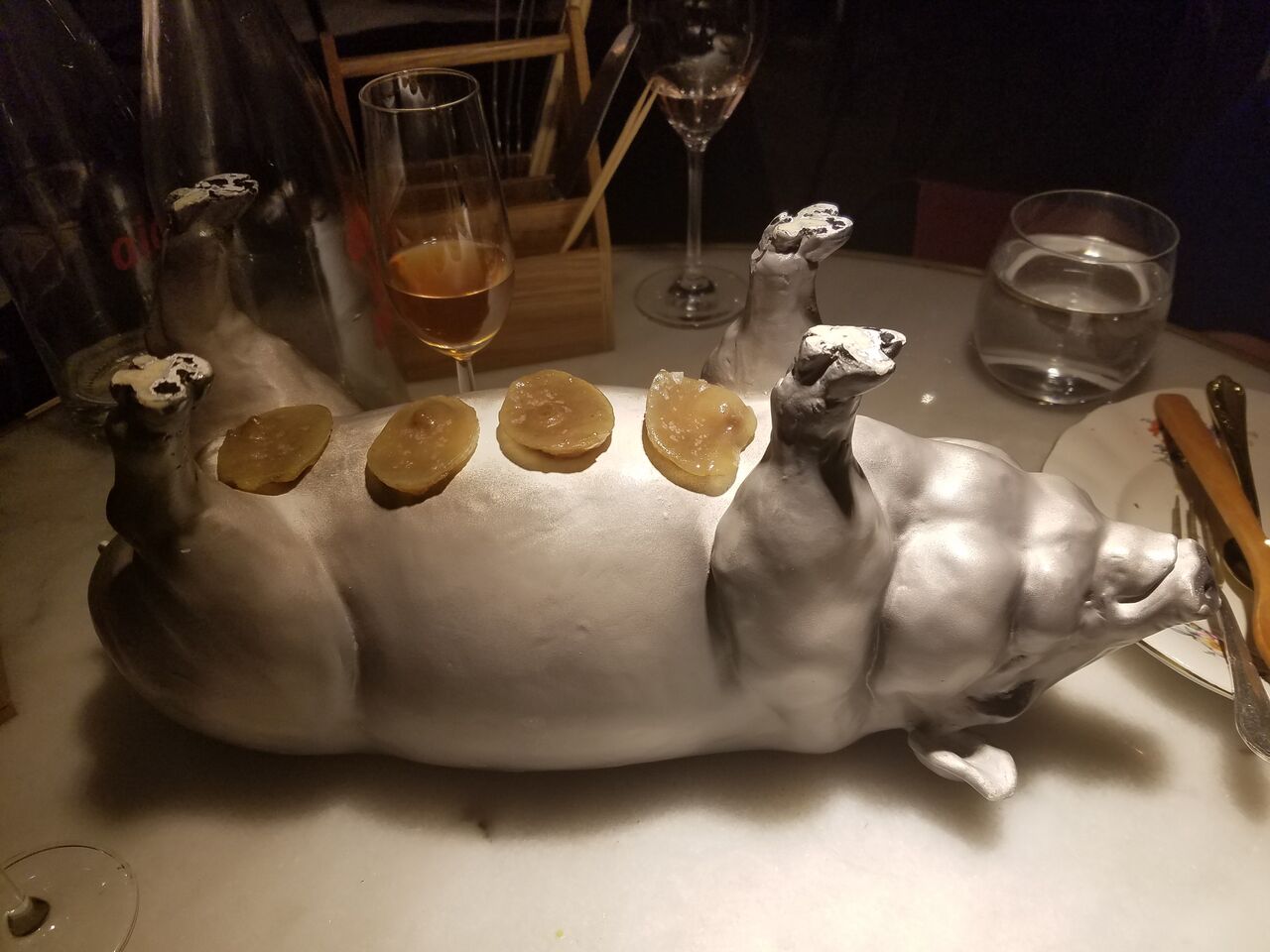
Photo: Gerry Dawes
At Asia Madrid Fusión 2017, held in January at Madrid’s Palacio de Congresos, I went to photograph Barcelona Chef Albert Raurich’s presentation and I became interested in the culinary historic timeline for the dishes he serves at his restaurant Dos Pebrots in the up-and-coming neighborhood of el Raval. Raurich´s timeline stretches from the Paleolithic and Neolithic eras to 1929, with many dishes inspired by the foods of ancient Egypt and the Roman Empire.
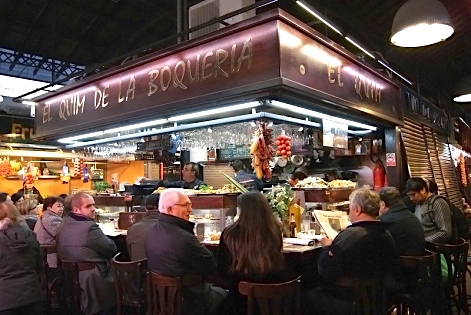 A few days later in
Barcelona I made an 8 o’clock reservation at the
restaurant, but my fiancée and I first returned for
lunch to an old favorite where I had eaten scores of
times, El Quím de la Boquería, one of the
world’s greatest market bars. After scoring a couple
of taburetes
(bar stools), I began to realize that Chef Quím Marquéz (below), his ingredients, cooking
style, and his cooking crew, which now includes his
son, Yuri, had moved to another dimension. We
sat to a multi-course meal of five-star, world class
dishes.
A few days later in
Barcelona I made an 8 o’clock reservation at the
restaurant, but my fiancée and I first returned for
lunch to an old favorite where I had eaten scores of
times, El Quím de la Boquería, one of the
world’s greatest market bars. After scoring a couple
of taburetes
(bar stools), I began to realize that Chef Quím Marquéz (below), his ingredients, cooking
style, and his cooking crew, which now includes his
son, Yuri, had moved to another dimension. We
sat to a multi-course meal of five-star, world class
dishes.
Knowing that at Quím I usually drink rosat cava sparkling wine, Quím’s staff immediately poured us flutes of the excellent Cava Juvé y Camps 100% Pinot Noir Rosé Reserva Brut, a delicious methode champenoise wine that makes a fine match for the food you are likely to be served here.
Our first dish, a favorite of mine, was gambas al
ajillo (shrimp with black garlic from China),
at Quím a modernized version of one of Spain's most
ubiquitous dishes; it comes on a plate instead of in
the traditional cazuela
(clay casserole dish), the shrimps spread across a
pepper-flecked pool of addictive, slightly picante seafood,
garlic and Cava juices that sent us to the
breadbasket a couple of times to mop it all up.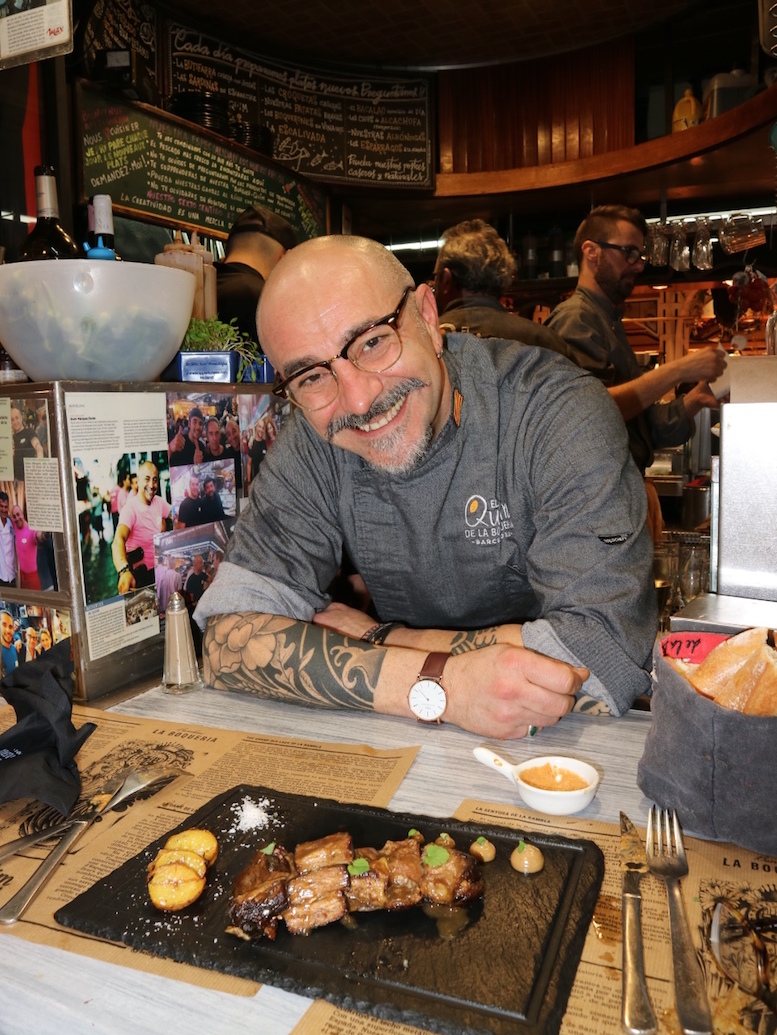
A dish new to me here, but one that seems to be making the rounds in Spain, was a superb ceviche de corvina, with passion fruit, mango, onions and aji amarillo. Next was huevos fritos con chanquetes, a classic served in a small paella pan—two fried eggs topped with pan-tossed tiny whitebait, with the yolk of the eggs as a divine sauce.
Believe it or not, Quím also has a place in Hong Kong, so it is not surprising that he has picked up some Chinese cooking skills, as in the crispy fried dumpling filled with rabo de toro (oxtail) with a soy-infused dipping sauce. My weakness for leeks and romesco sauce was indulged with calçots con vieras, chipirones y romesco, young tempura-battered onions resting at an angle atop scallops on a bed of baby squid and julienned carrots and onions, with a romesco schmeer on the side, all served on a thin black slate slab,
On another slab of black slate, Quím served us our last
course, his modernized version of roasted costillas de
ternera (veal ribs) with rounds of roasted
potatoes, Maldon salt with dollops of black Chinese
garlic aïoli alongside. For dessert, with the
last sips of the wine, we enjoyed a cheesecake with
passion fruit.
Photo: Gerry
Dawes
Open daily.
Only a few hours later,
we walked over to Dos
Pabrots and met with Chef Raurich. He didn’t
say anything about the pig tits, but how many
restaurants in Spain have a ceramic pig, feet to the
sky, whose underbelly is lined with four sliced off,
grilled Ibérico
pig tits, tetas
de cerda Ibérica, as a star course? We took a
seat at table by the bar and began to peruse the
long menu—carta
dos ets albert raurich versión VI—on whose
flip side is Raurich’s culinary timeline. Since
there were 34 dishes, plus seven desserts, I began
to mark candidates for ordering with my
pen.
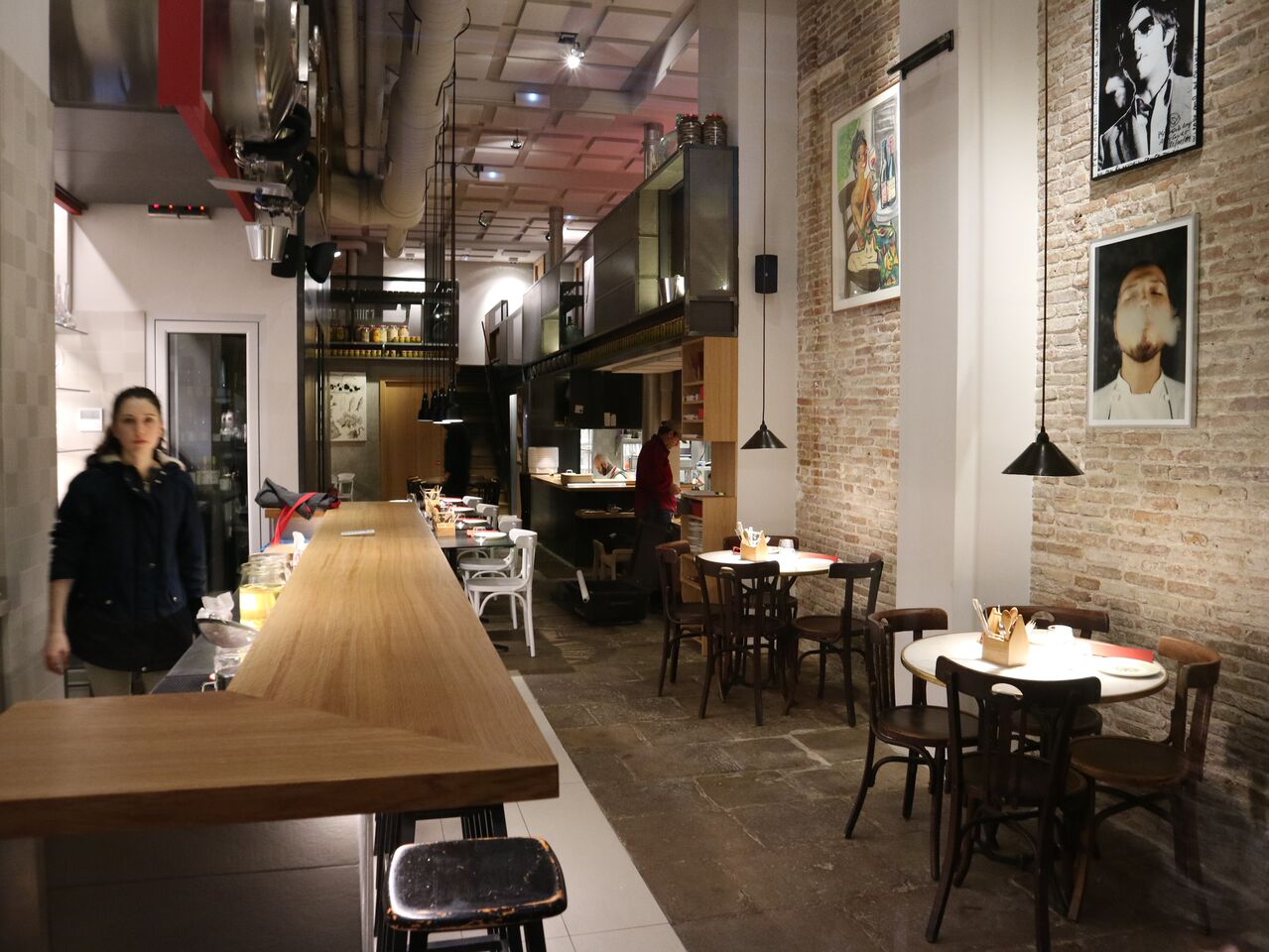 The
menu is composed of seven columns: elaboración
final (the name of the dish), productos
principales (main ingredients), técnica
principal (roasting, braising, frying, etc.),
origen de la
elaboración (period from which the dish
originated; Al-andalus
10th Century/ancient Persia 1500 B.C., etc.), herramiento (utensils,
including
hands, used to eat the dish: a small carpenter’s
"toolbox" contains silverware, wooden spoons,
chopsticks and skewer) and, finally, precio (the
generally reasonable price in Euros of each dish). A note on
the menu says “If you do not understand this menu,
ask a waiter, who perhaps may
understand it."
The
menu is composed of seven columns: elaboración
final (the name of the dish), productos
principales (main ingredients), técnica
principal (roasting, braising, frying, etc.),
origen de la
elaboración (period from which the dish
originated; Al-andalus
10th Century/ancient Persia 1500 B.C., etc.), herramiento (utensils,
including
hands, used to eat the dish: a small carpenter’s
"toolbox" contains silverware, wooden spoons,
chopsticks and skewer) and, finally, precio (the
generally reasonable price in Euros of each dish). A note on
the menu says “If you do not understand this menu,
ask a waiter, who perhaps may
understand it."
Photo:
Gerry Dawes
We ordered a bottle of Raventós i Blanc de Nit, a
superb Champagne-quality rosat sparkling
wine from the newly minted Conca del Rìu Anoia D. O.
and I began to zero in on our choices. The
menu recommends that if you do not have mucha hambre
(are not very hungry), you should order only 5-6
plates, so we figured half a dozen dishes would be
perfect. 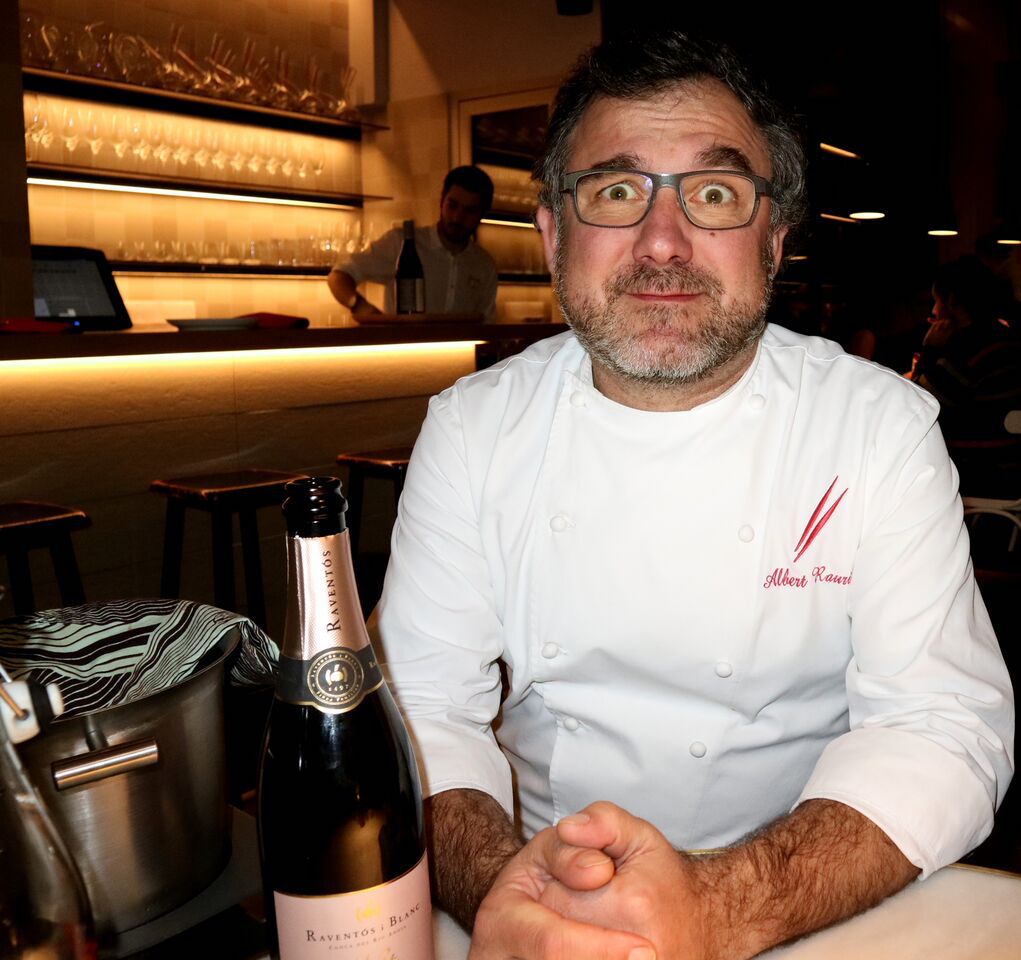
The parade
of dishes began with nicely done but too bland puerros
ancestrales, three two-inch sections of leeks
roasted with beer and vinegar, purportedly from
ancient Egypt.
Then came lovely, high quality beberechos con
salsa verde, steamed cockles with a green
sauce made with parsley, garlic and white wine,said
to date “from the first week in May of 1723.” Mollete de
Barbate, a David Chang-esque bun
stacked with almadraba tuna from the waters off
Barbate de Franco (Cádiz province, where the famous
tuna roundup takes place), came with cucumber and
tomato dressed with Spanish pimentón, garlic, vinegar
and cumin.
I was looking forward to the roasted cebolla negra, a Neolithic era-attributed “blackened onion” with garum, the legendary fermented Roman anchovy-fish sauce, but I was disappointed because the dish begged for a more flavorful roasted onion and a more assertive garum. And we didn’t eat the hay underneath the onion because it tasted like, well, hay. I brought the gentrified garum up with Raurich later and he promised the next time he will serve me a “brutal” version.
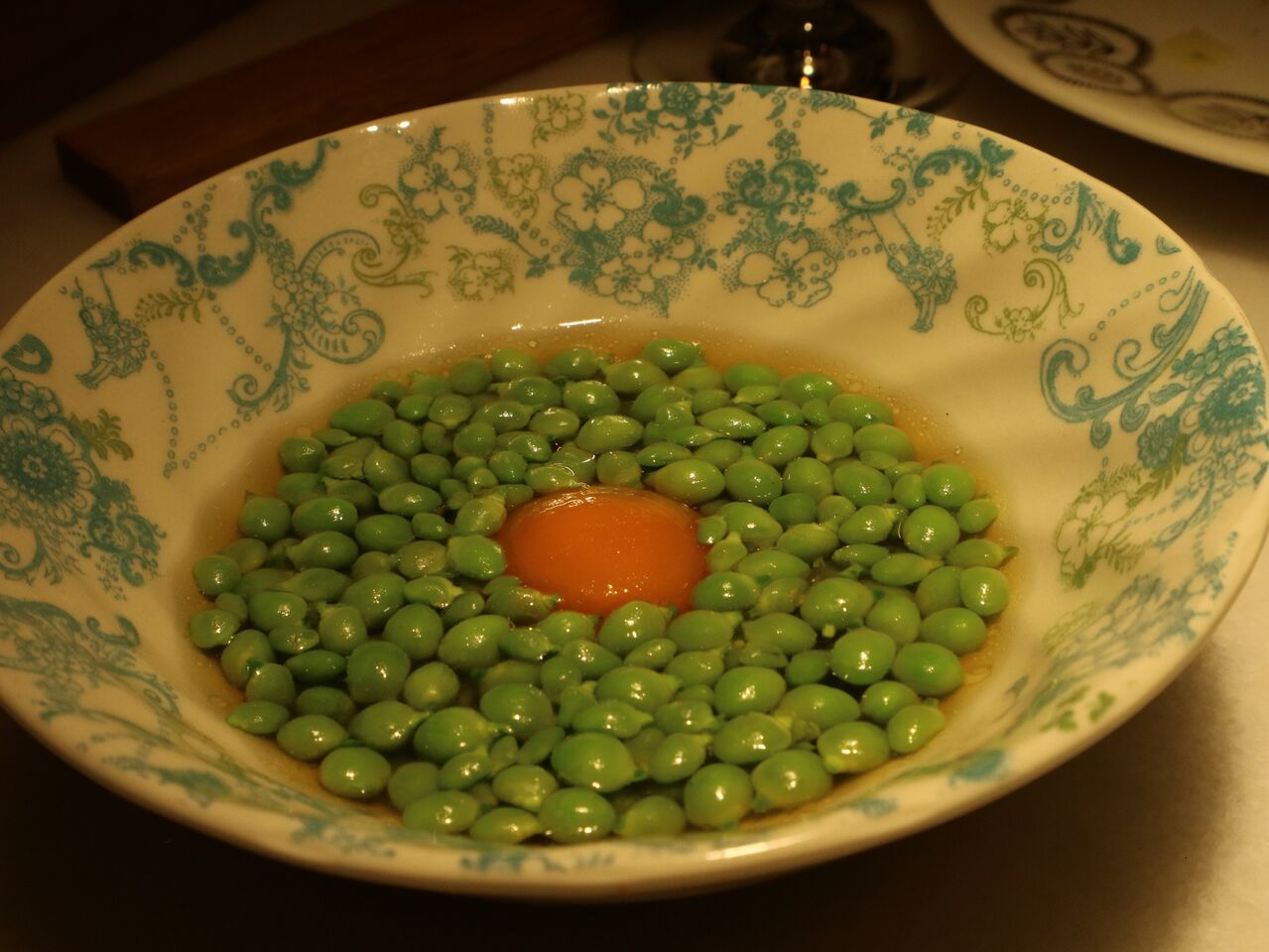 One of our
best choices was guisantes con
jamón, tender young peas in a jamón Ibérico
broth with a perfect egg yolk spooned into the dish
to further enrich the soup, whose inspiration
supposedly goes back to the time when the wine God
Bacchus was known as “the little pea.”
One of our
best choices was guisantes con
jamón, tender young peas in a jamón Ibérico
broth with a perfect egg yolk spooned into the dish
to further enrich the soup, whose inspiration
supposedly goes back to the time when the wine God
Bacchus was known as “the little pea.”
Photo: Gerry
Dawes
To round off our journey through
Raurich’s culinary history, I ordered the tortilla
unilateral de piñones, whose creation was
inspired by a recipe from the 1st Century BC. I chose
this “one-sided tortilla”
(omelet) with pine nuts, perifollo
(chervil), garum
and honey, which he had demonstrated at Madrid
Fusión.
A server then came to our table with a pad to
protect the surface, a hot cast-iron two-handled
skillet, a pair of palillos (chopsticks)
and the ingredients to whip up table-center the tortilla
unilateral de piñones, which was delicious, as
well as being one of the most visually attractive
dishes we tried.
We were not done, however. Unordered,
but sent out by Raurich, the tetas de cerda
Ibérica Maldonado confitadas arrived, served
on an upturned, feet-to-the-sky, ceramic “Ibérico”
sow with the gelatinous looking rounds of sliced-off grilled
tits confit, four of them, each strategically placed
where they might have been on a real pig.
Maldonado is a quality producer of jamones
Ibéricos de bellota, hams produced from
free-run Ibérico
pata negra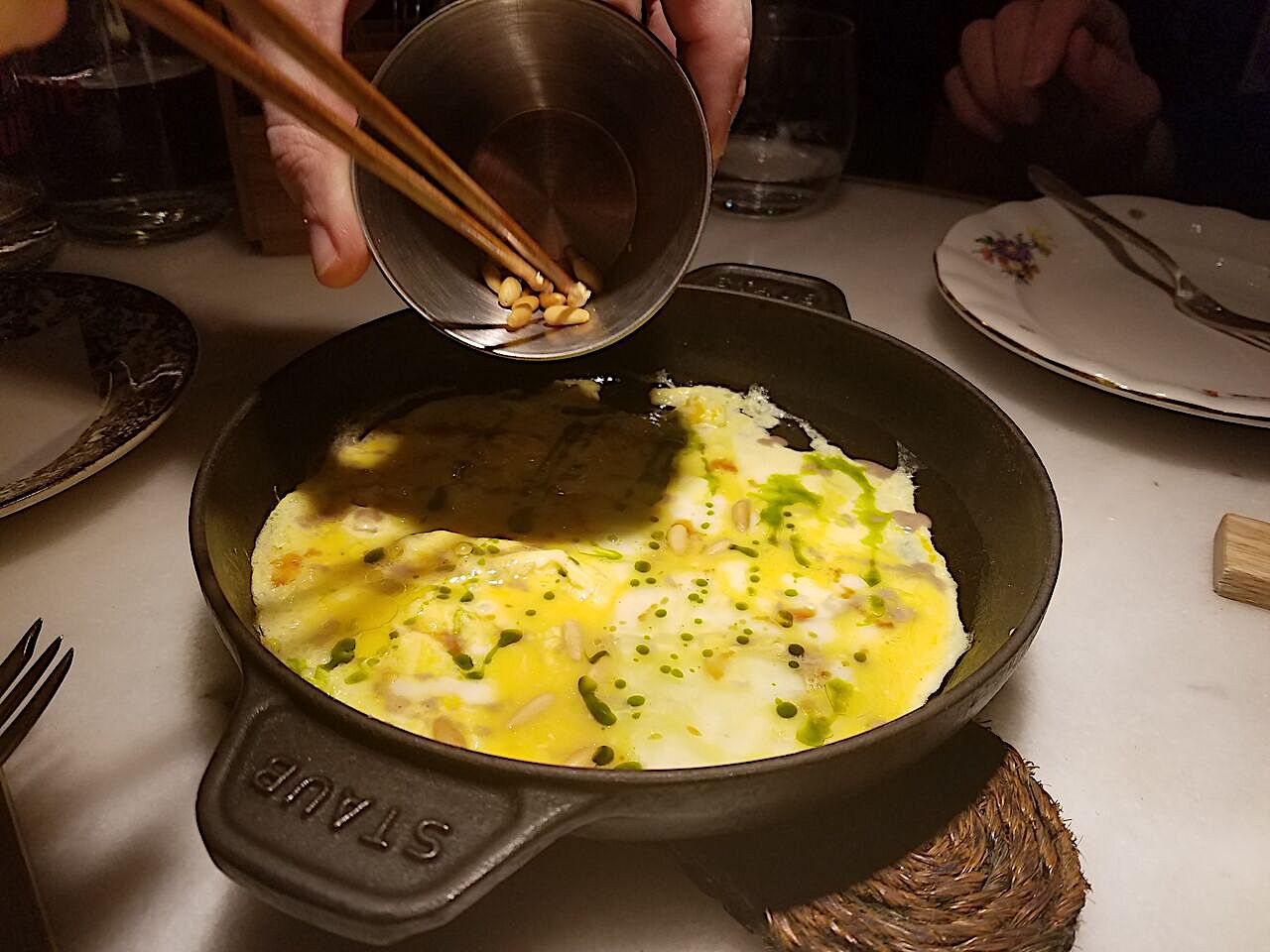 pigs
allowed to graze for two months under the oaks in
the Dehesa de Extremadura D. O. of western
Spain. I am sure Maldonado´s jamones
Ibéricos de bellota must be stupendous, but
these were tetas,
acorn-flavored or not. Excepting the Sherry glass
with a side chaser of Ibérico
broth, this dish supposedly dates back to the
Romans, where it must have been the rage at orgies,
sliced off real pig carcasses. Photo: Gerry Dawes
pigs
allowed to graze for two months under the oaks in
the Dehesa de Extremadura D. O. of western
Spain. I am sure Maldonado´s jamones
Ibéricos de bellota must be stupendous, but
these were tetas,
acorn-flavored or not. Excepting the Sherry glass
with a side chaser of Ibérico
broth, this dish supposedly dates back to the
Romans, where it must have been the rage at orgies,
sliced off real pig carcasses. Photo: Gerry Dawes
It is tempting to guess that the
decline of the Roman Empire began precisely with the
presumed rise in the popularity of this dish.
Raurich had been Ferran Adrià´s Chef de Cuisine at el Bulli from 1997 to 2007, and for the past decade he has been doing creative cooking at his Asian food-themed, open-kitchen Dos Palillos (Chopsticks), which he owns with his Japanese wife-sommelier, Tamae Imachi, and is located just around the corner from Dos Pebrots.
Raurich is a serious student of food and the history of food. He is also an amusing, fun-loving guy with a great sense of humor. High on the wall at the exit end of the restaurant, he has placed a photograph of the main players at chef Ferran Adrià’s el Bulli, the famous, now-closed cocina de vanguardia restaurant north of Barcelona that was often touted as the best in the world. Looking like a rather roughshod band of fishermen is the crew of now culinary superstars that made el Bulli into a legend: Raurich, the late el Bulli co-owner Juli Soler, Ferran Adrià, Oriol Castro, Mateu Casañas, Eduard Xatruch (these last three are chef-owners at one of Barcelona’s best new restaurants, Distfrutar), and Albert Adrià, the genius behind the highly acclaimed Tickets, Bodega 1900, Pakta, Hoja Santa and more.
The sow tetas not withstanding, I found the concept at Dos Pebrots fascinating, a trip down a little-known historical culinary trail that Chef Raurich is blazing and that, no doubt soon, admiring chefs will begin to imitate. Raurich’s ideas and execution are terrific and the history-based dish ideas will continue to grow as he expands his intellectual pursuit of long-lost culinary concepts. Dos Pebrots is indeed a trip back in time, with some very refined modern creative touches from the mind and talent of a great chef.
Open Wed.-Sun. 1 p.m.-11p.m.
❖❖❖
By John Mariani
and MOZZARELLA E VINO
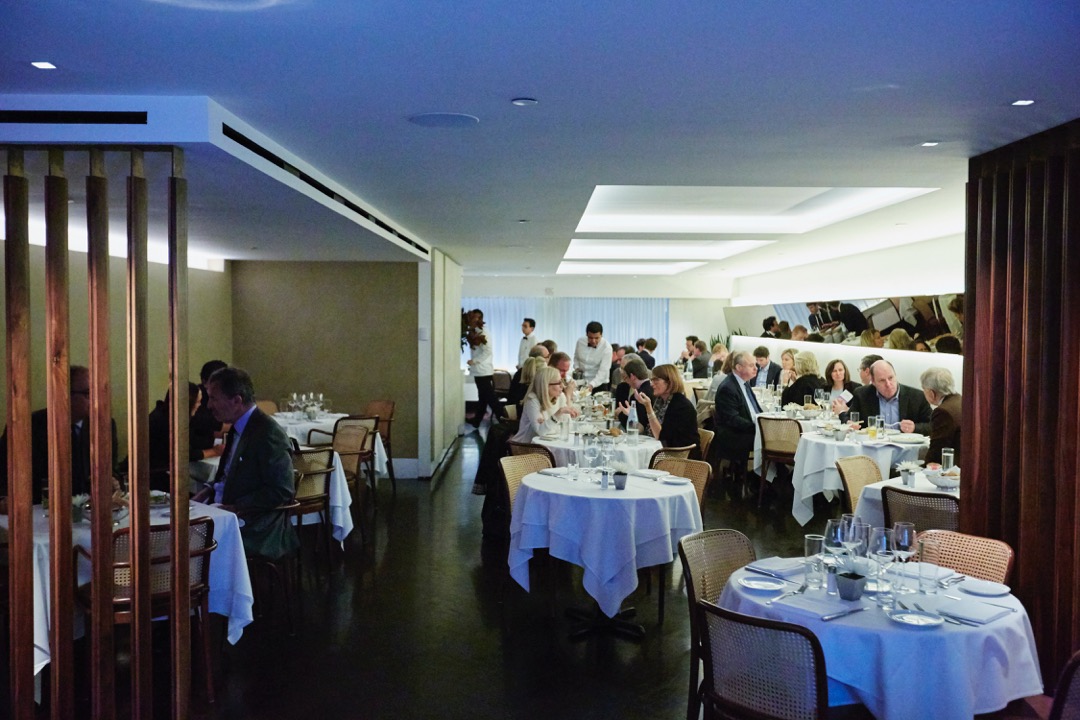
To run three
successful restaurants in NYC is remarkable
enough, but when two are very fine dining
and one the epitome of casual chic, all
located on the posher streets of mid-town
Manhattan and the Upper West Side, the
achievement is all the more extraordinary. Il
Gattopardo, in a former Nelson Rockefeller
townhouse across from the Museum of Modern
Art, and The Leopard at Des Artistes near
Lincoln Center rate among the city’s best
Italian restaurants, while Mozzarella e
Vino, just doors from Il Gattopardo, has
been a draw for New Yorkers and
out-of-towners who have just visited the
museum or been buying their Armani and Ralph
Lauren outfits on Fifth Avenue. All are run by
Gianfranco and Paula Sorrentino and Chef
Vito Gnazzo (below), who bound
between the three restaurants daily and
keep a civilized level of familiarity with
their legion of regular guests. I
wrote about The Leopard a few months ago,
so let me now concentrate on Il Gattopardo
and Mozzarella e Vino.
IL GATTOPARDO
13-15 West 54th Street (near Fifth Avenue)
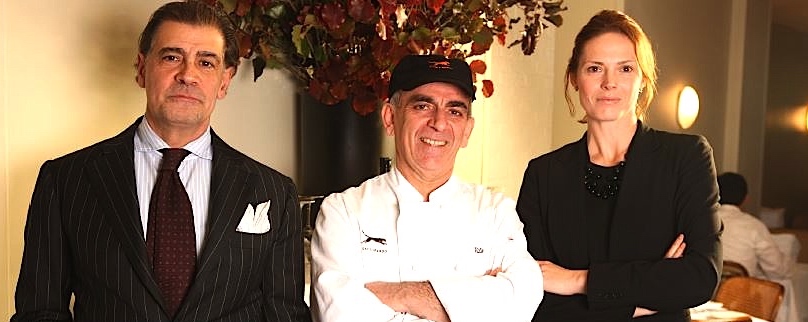 Named
after the great Giuseppe di Lampedusa’s 1958
novel of Sicilian life, Il Gattopardo is spread
on two floors of the Rockefeller Beaux Art
townhouse; upstairs is the main dining room,
downstairs a vast party room, and in their
streamlined minimalist décor both make good
stylistic neighbors to MOMA across the street.
The lighting is soft and glowing in the dining
room, the walls free of artwork, and the
comfortable chairs, double tablecloths, thin
wineglasses, fine china and fresh flowers
maintain the metropolitan level of
sophistication.
Named
after the great Giuseppe di Lampedusa’s 1958
novel of Sicilian life, Il Gattopardo is spread
on two floors of the Rockefeller Beaux Art
townhouse; upstairs is the main dining room,
downstairs a vast party room, and in their
streamlined minimalist décor both make good
stylistic neighbors to MOMA across the street.
The lighting is soft and glowing in the dining
room, the walls free of artwork, and the
comfortable chairs, double tablecloths, thin
wineglasses, fine china and fresh flowers
maintain the metropolitan level of
sophistication.
The mostly Italian
wine list exceeds 300, all selected by the
affable
Gianfranco
himself, and you’ll find plenty of well-priced
wines under $50. Vito
Gnazzo, from Salerno, had worked at the renowned
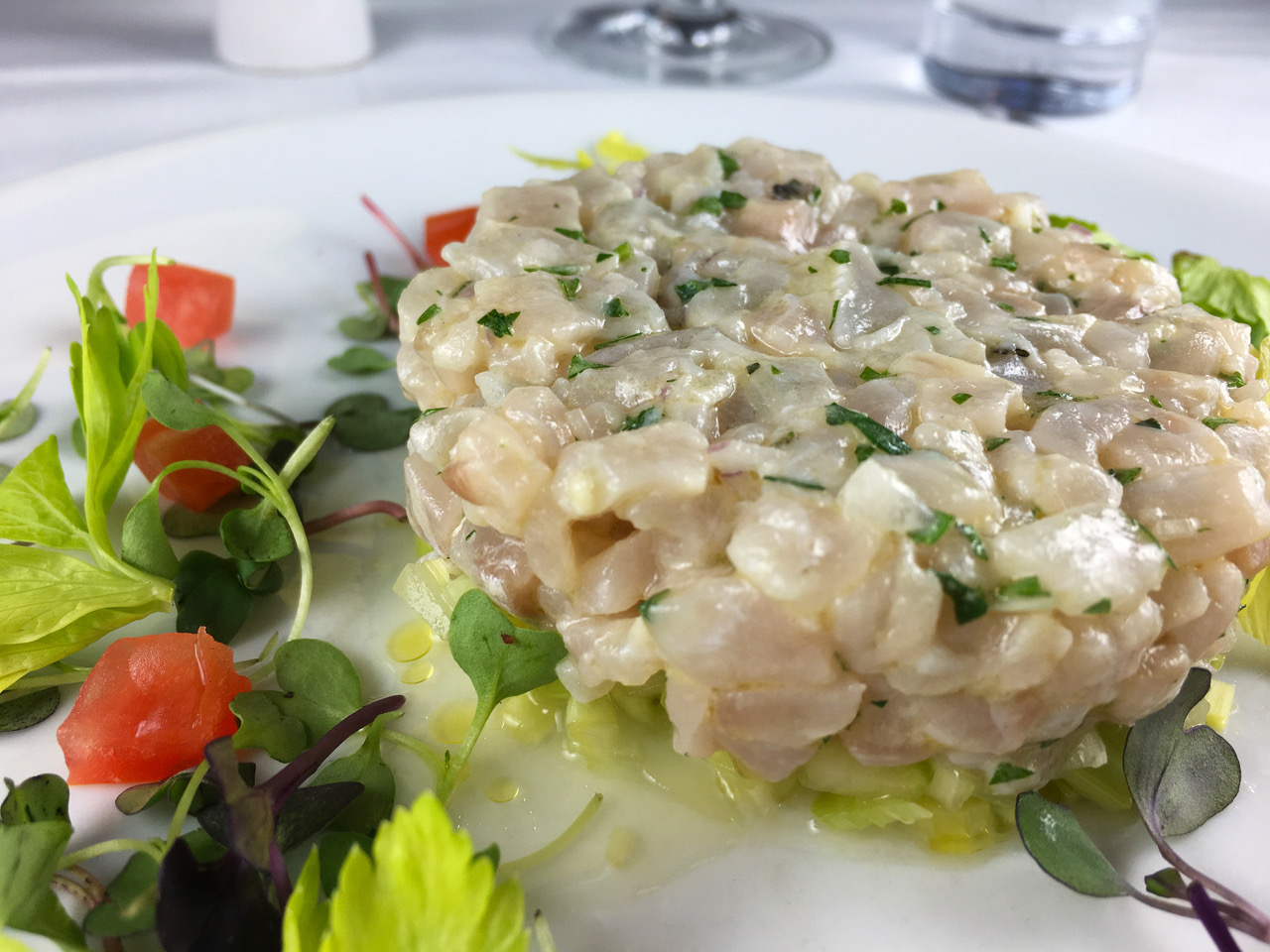 Antica Osteria del
Ponte outside Milan, then at the equally
esteemed Rex in Los Angeles. At Il Gattopardo he
shows a further refinement of cucina
Italiana, beginning with lustrous crudo
of branzino (right)
with cucumber, celery and lemon-olive oil
dressing ($24) that is perfect for these
springtime evenings. He also does a very
southern salad of pickled eggplant, cherry
tomatoes, spring onions and toasted croutons
($18). Particularly
imaginative is Gnazzo’s finely sliced silky veal
loin that has been smoked in house and set over
organic greens with asparagus tips and oven
roasted tomatoes in a balsamic vinegar and olive
oil dressing ($24).
Antica Osteria del
Ponte outside Milan, then at the equally
esteemed Rex in Los Angeles. At Il Gattopardo he
shows a further refinement of cucina
Italiana, beginning with lustrous crudo
of branzino (right)
with cucumber, celery and lemon-olive oil
dressing ($24) that is perfect for these
springtime evenings. He also does a very
southern salad of pickled eggplant, cherry
tomatoes, spring onions and toasted croutons
($18). Particularly
imaginative is Gnazzo’s finely sliced silky veal
loin that has been smoked in house and set over
organic greens with asparagus tips and oven
roasted tomatoes in a balsamic vinegar and olive
oil dressing ($24).
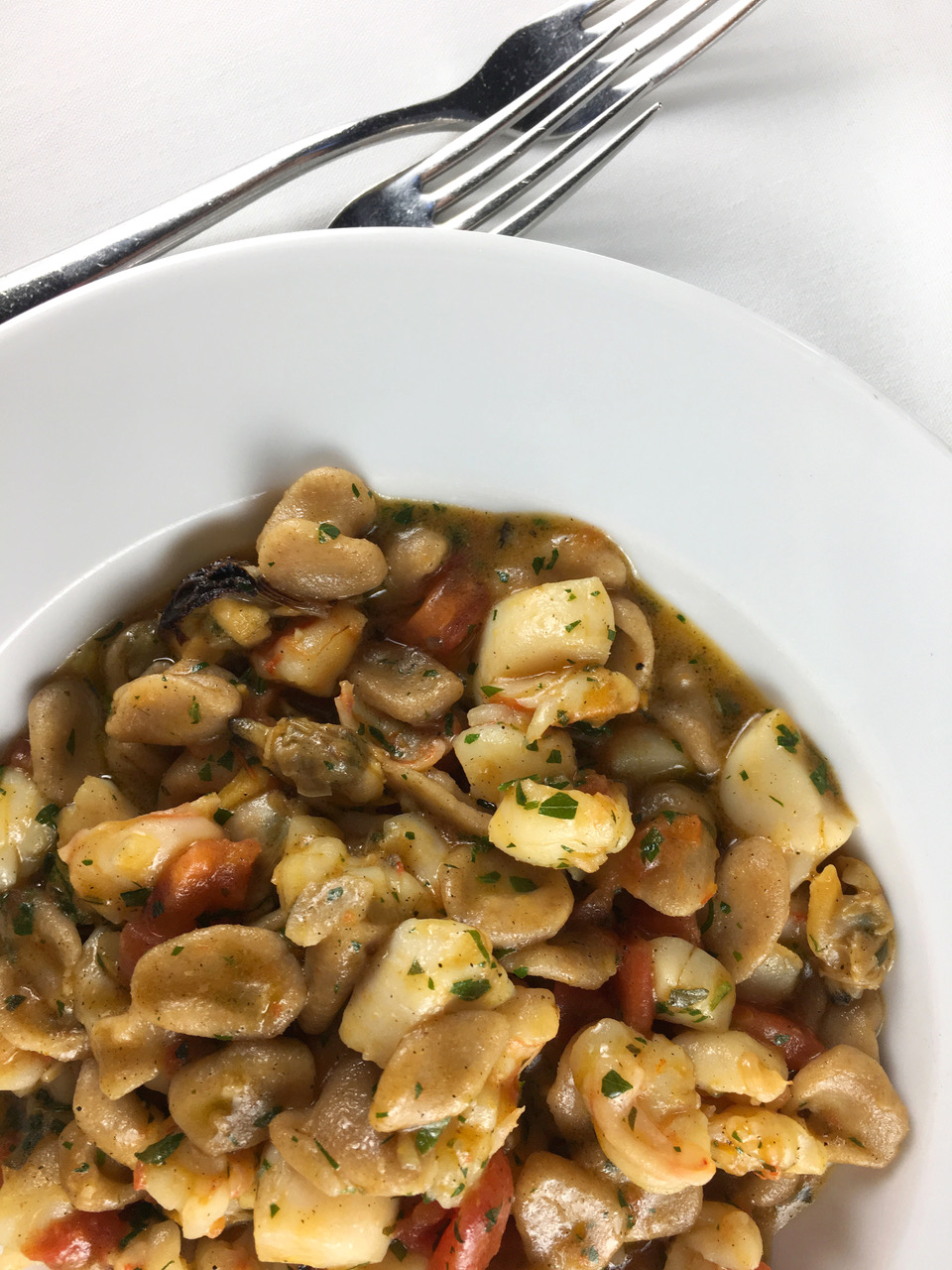 The
winsome star-shaped fagottini
pasta covers organic spring greens and buffalo
ricotta in a fresh tomato sauce seasoned with
fresh marjoram ($26), while plump potato gnocchi
shares the bowl with sweet chunks of penniolo
tomatoes from the area around Vesuvius and
nubbins of scamorza cheese ($26). My favorite
pasta on a recent evening was firm little cavatelli (left) with
grains and herbs in a deeply flavorful shellfish
broth ($28).
The
winsome star-shaped fagottini
pasta covers organic spring greens and buffalo
ricotta in a fresh tomato sauce seasoned with
fresh marjoram ($26), while plump potato gnocchi
shares the bowl with sweet chunks of penniolo
tomatoes from the area around Vesuvius and
nubbins of scamorza cheese ($26). My favorite
pasta on a recent evening was firm little cavatelli (left) with
grains and herbs in a deeply flavorful shellfish
broth ($28).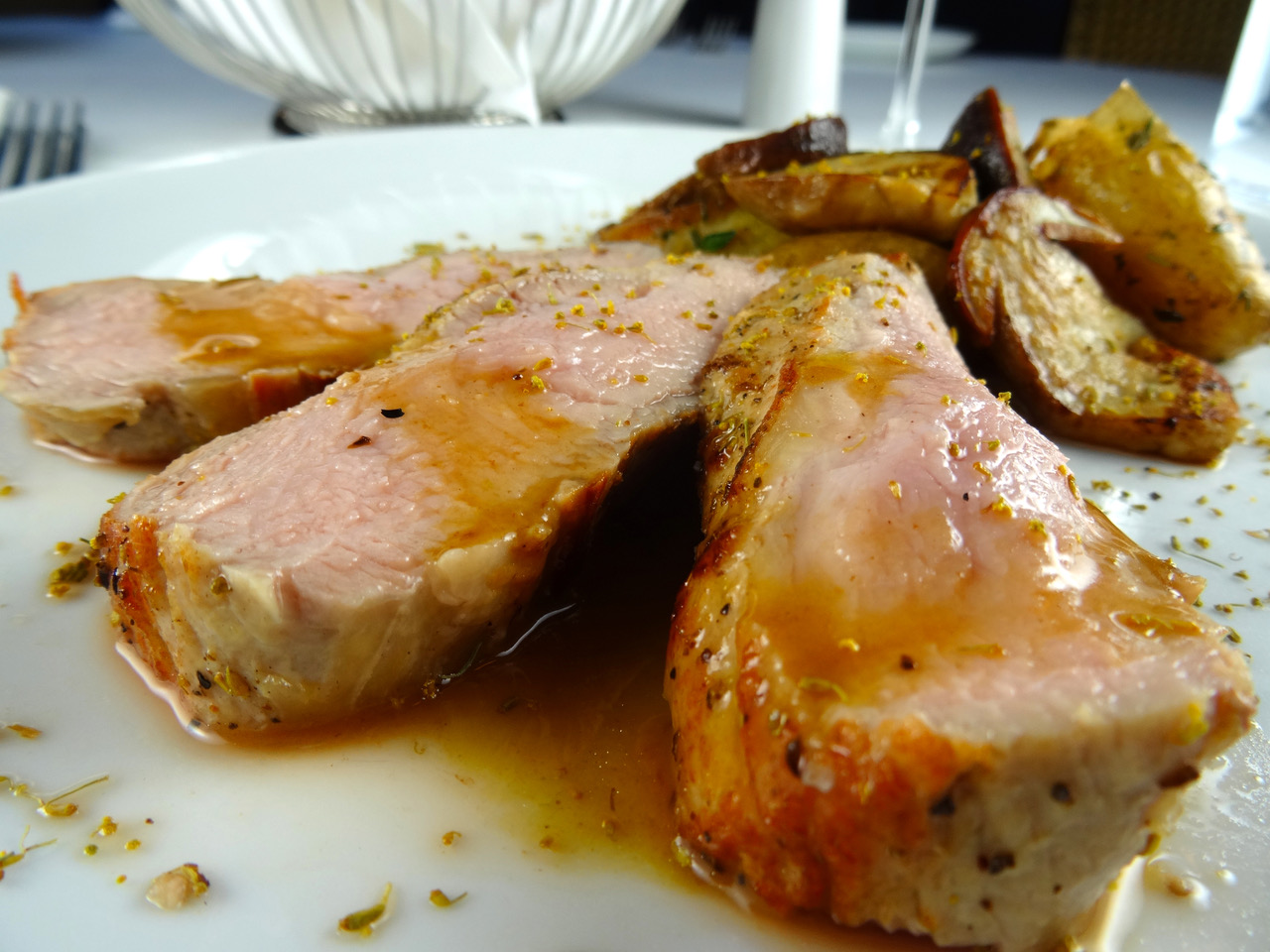
For
main courses, it would be difficult to find a
better rendering of pan-seared veal loin (right),
here scented with wild fennel pollen (from
Gnazzo’s own farm) served with buttery
fingerling potatoes and woodsy porcini
mushrooms, graced with a light reduction of the
meat’s juices ($50). If you like rabbit, you
will be enthralled by the braised leg with
roasted artichokes and fingerling potatoes
($43). One main course that never leaves the
menu is the very popular Neapolitan meatloaf
($30), suffused with flavors of long-cooked
vegetables and seasonings, served with
chive-dotted mashed potato and garlic-rich
spinach.
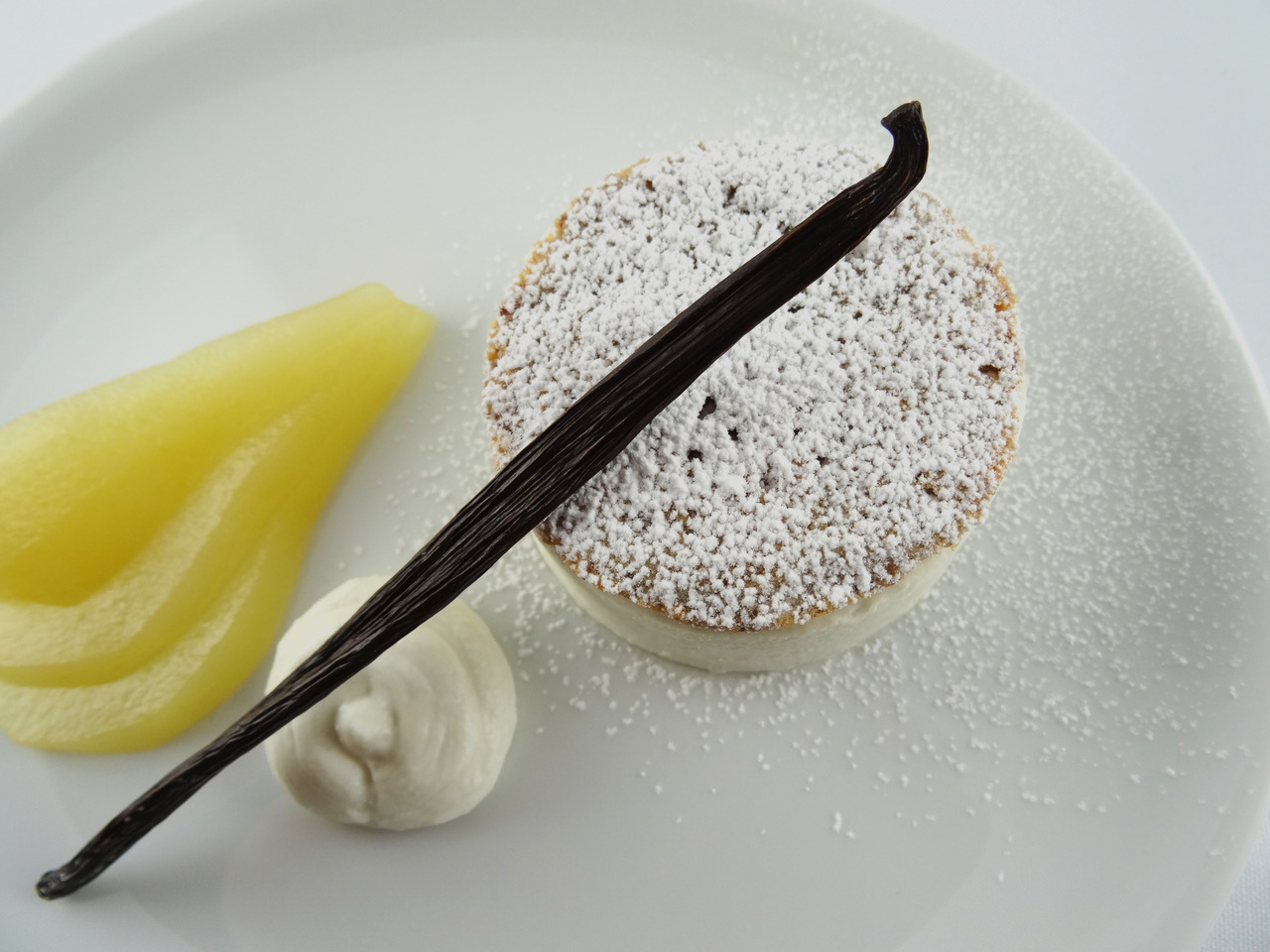 There
is no reduction of quality and creativity in
desserts at Il Gattopardo, by Pietro Macellaro,
which goes way beyond the usual
with a semifreddo of pear and ricotta di
bufala with hazelnut biscotto ($14);
mousse di
cioccolato with a Aglianico wine heart jelly
($14) and marvelous rum-soaked “Babbá del
Re” with fresh panna
montata
and strawberries ($14). Pastiera,
the homey traditional Neapolitan cheese cake
($14), never leaves the menu for good reason.
There
is no reduction of quality and creativity in
desserts at Il Gattopardo, by Pietro Macellaro,
which goes way beyond the usual
with a semifreddo of pear and ricotta di
bufala with hazelnut biscotto ($14);
mousse di
cioccolato with a Aglianico wine heart jelly
($14) and marvelous rum-soaked “Babbá del
Re” with fresh panna
montata
and strawberries ($14). Pastiera,
the homey traditional Neapolitan cheese cake
($14), never leaves the menu for good reason.
Ristoranti serving alta cucina
of this quality are rare even in Florence, Rome
and Naples, so to have Il Gattopardo and its
sister restaurant, The Leopard, within a mile of
one another is exemplary of NYC’s Italian
restaurants at their finest.
Open for lunch, Mon – Fri.;
brunch Sat & Sun; dinner nightly
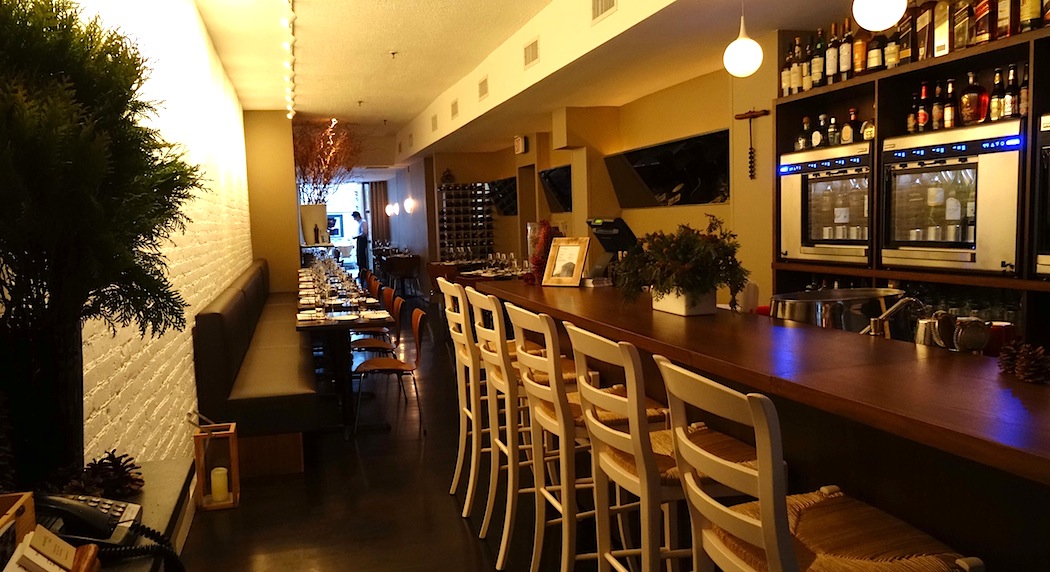
MOZZARELLA E VINO
33
West 54th Street (near Fifth Avenue)
646-692-8849
M&V, as I shall call
it, occupies the former premises of Il
Gattopardo, a long skinny room that opens up to
a patio outside that is highly desirable this
time of year.
As its name suggests,
the focus here is on an array of Italian cheeses
and wines, all imported, along with excellent
Italian charcuterie, best enjoyed as a tasting
of many that may include provola, burrata, smoky
scamorza, 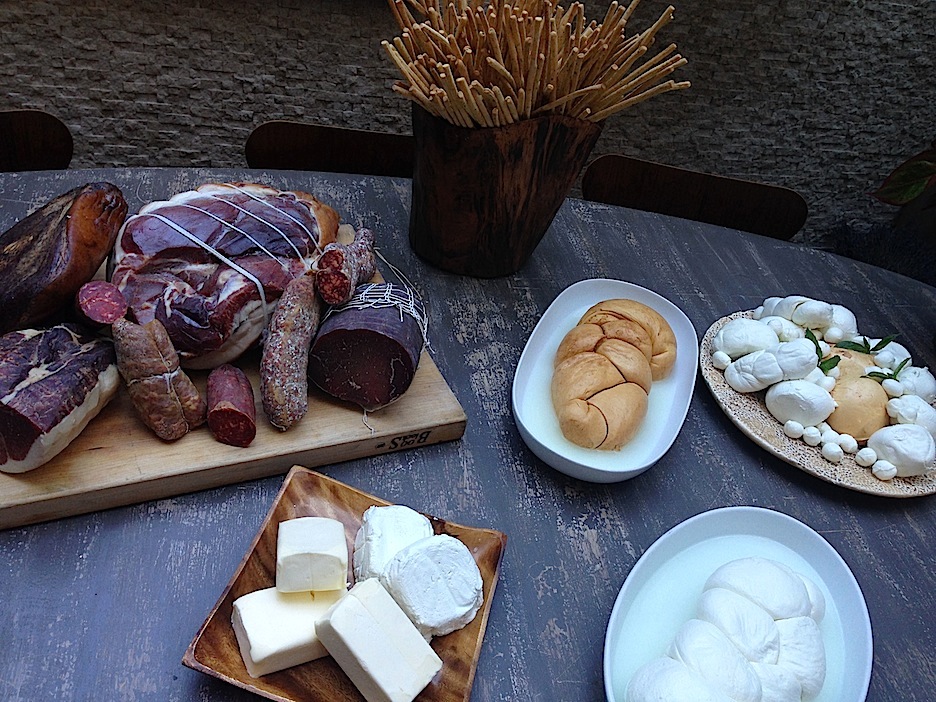 eggplant-stuffed
mozzarella, basil-scented mozzarella, various
prosciutti, bresaola, Speck, mortadella, and
rare culatello.
eggplant-stuffed
mozzarella, basil-scented mozzarella, various
prosciutti, bresaola, Speck, mortadella, and
rare culatello.
Prices
for such samplings, served on a rustic wooden
board, range from $9 for two to $17 for four.
You might also consider the array of panini
sandwiches ($13-$15 that include Prosciutto San
Daniele, robiola cheese and
grilled eggplant on ciabatta bread; artisanal
focaccia with natural untreated ham and wild
greens on extra virgin olive oil; ciabatta bread
with grilled eggplant, green zucchini, yellow
squash and tomato, and more.
You
should
also consider the items from the friggitoria
list—fried dishes, including rice ball
arancini, fat panzarotti pasta filled with
potato, mozzarella and salami, and golden fried
zucchini. You won’t find them  better anywhere.
better anywhere.
Pastas
and other main courses have increased since
M&V opened four years ago, and, on a night
when Chef Gnazzo plucked victory from the
prospect of defeat—a holiday in Italy delayed a
shipment of mozzarella and other cheeses!—he
served us as splendid an array of dishes as
you’d find anywhere around town, starting with
an abundant seafood salad of calamari, mussels
and shrimp over organic friseé and arugula with
oven-dried cherry tomatoes and an extra virgin
olive oil, lemon and parsley dressing.
Also bright and seasonal was a citrus and
avocado salad with fennel and Gaeta olives, with
a fresh mint dressing; then came a lavish plate
of the day’s ravioli, filled with ricotta and
served with organic tomatoes. Rarely
am I impressed with buckwheat pasta, but
M&E’s buckwheat fettucine with cherry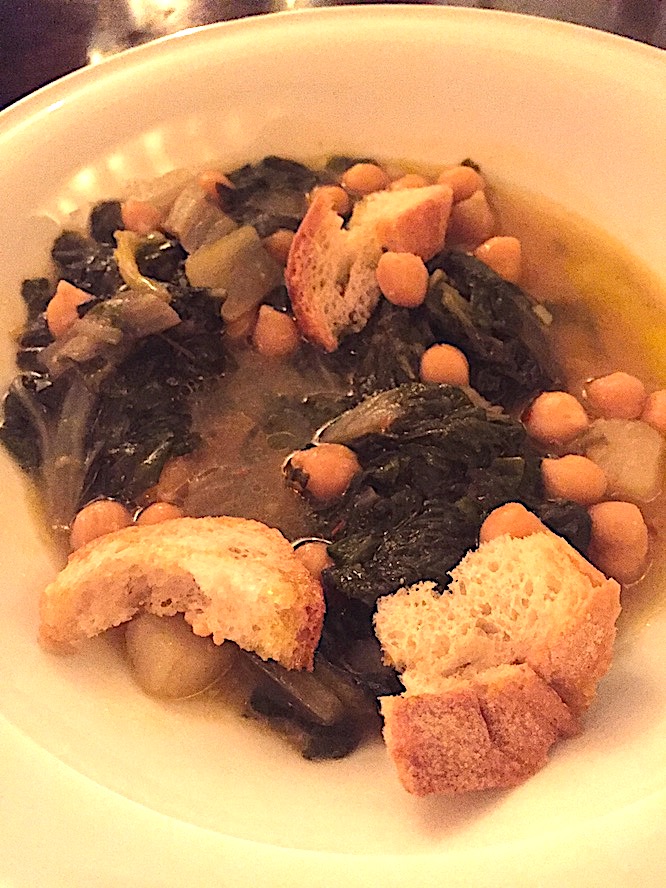 tomatoes and basil sauce had just
the right tenderness along with a true nutty
flavor that went well with the dressing. So,
too, a warm organic farro salad with roasted
vegetables and prosciutto di Parma was the kind
of homey dish you’d come across in a tiny
mom-and-pop trattoria in Naples.
tomatoes and basil sauce had just
the right tenderness along with a true nutty
flavor that went well with the dressing. So,
too, a warm organic farro salad with roasted
vegetables and prosciutto di Parma was the kind
of homey dish you’d come across in a tiny
mom-and-pop trattoria in Naples.
We ended off with a
rich torta di mascarpone “tiramisu” style.
Drop
in for a snack and glass of wine, stay for a
meal of cheese and meats, or spend the night
feasting.
M&V aims to please on any and every
count, and with spring in fill bloom an outdoor
table is pretty sublime.
Mozzarella & Vino is open
Mon.-Sat from 11:30 a.m. to 10 p.m., Sundays
from 11:30 to 5.
WHAT I'M DRINKING NOW
By John Mariani

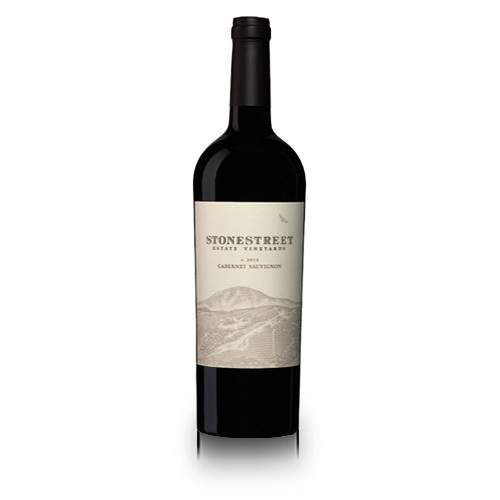 STONESTREET ESTATE
VINEYARDS ESTATE CABERNET SAUVIGNON 2014 ($45)—A
very vibrant wine on all counts—bold fruit,
moderate tannins, non-invasive acids and
admirable alcohol level (13.5%)—that shows how
refinement is reached at higher altitudes in
Sonoma’s Mayacamas Mountains, up to 2,400 feet.
Aging is in 32% new French oak for 18 months, in
bottle for another year. Winemaker Lisa
Valtenbergs and the Jackson family that owns
Stonestreet (the family’s middle name) should be
very happy with achieving this kind of elegant
balance in their Cab.
STONESTREET ESTATE
VINEYARDS ESTATE CABERNET SAUVIGNON 2014 ($45)—A
very vibrant wine on all counts—bold fruit,
moderate tannins, non-invasive acids and
admirable alcohol level (13.5%)—that shows how
refinement is reached at higher altitudes in
Sonoma’s Mayacamas Mountains, up to 2,400 feet.
Aging is in 32% new French oak for 18 months, in
bottle for another year. Winemaker Lisa
Valtenbergs and the Jackson family that owns
Stonestreet (the family’s middle name) should be
very happy with achieving this kind of elegant
balance in their Cab.
CLOS DU VAL ESTATE CHARDONNAY 2015 ($32)—Clos du Val won my affections long ago as a California producer whose French bloodline showed in the finesse of its Cabernets. And while I am not a big fan of their current Pinot Noir, I was delighted to find their Chardonnay ripe without being cloying, with just a touch of oak, so that it may remind you of the better Chablis now being made in Burgundy. The grapes are all from Carneros, where fickle weather in 2015 made for a small crop but also helped concentrate the flavors that evolved into good sugar and complexity.
CASTELLO DI ALBOLA CHIANTI CLASSICO RISERVA 2012 ($17 )—Chianti Classico has no bigger fan than I, and this Riserva proves why. The estate, in Radda, dates back to the 1840s and breeding shows in the layers of flavor, that wonderful Chianti fruit, the little bite of acid and the softening backbone. There is a fine bouquet when opened and sniffed, and the wine lasts a long while on the palate. It’s made to be drunk with just about anything that lives on land.
EMBLEM
CABERNET
SAUVIGNON 2013 ($35)—“Emblem is the
latest chapter in our family story that spans
for generations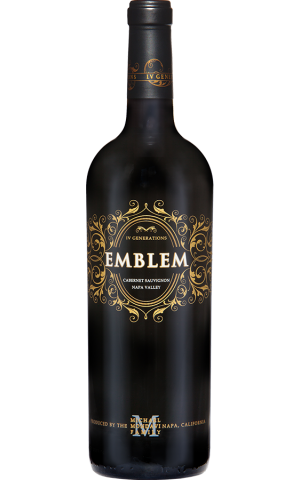 crafting world-class
wine in the Napa Valley.” So
reads the back of the bottle of this stellar
wine, which really shows that the inspirational
example of Robert Mondavi lives on in his son
Michael’s vineyard. A high percentage of new
French oak and 15 months aging helps emphasize
the dark fruit and subtle sweetness, added to by
blending with Syrah,
Petite Sirah, Zinfandel, and Petit Verdot. The
wholly sensible 14.4% alcohol also makes this
a splendidly adaptable wine for a wide range
of summer’s dishes, and at $35, you won’t find
a better Cabernet.
crafting world-class
wine in the Napa Valley.” So
reads the back of the bottle of this stellar
wine, which really shows that the inspirational
example of Robert Mondavi lives on in his son
Michael’s vineyard. A high percentage of new
French oak and 15 months aging helps emphasize
the dark fruit and subtle sweetness, added to by
blending with Syrah,
Petite Sirah, Zinfandel, and Petit Verdot. The
wholly sensible 14.4% alcohol also makes this
a splendidly adaptable wine for a wide range
of summer’s dishes, and at $35, you won’t find
a better Cabernet.
ASKOS MASSERIA LE VELI SUSUMANIELLO 2015 ($20)—This IGT red from Salento in Puglia indicates the fast-rising level of quality wines in Southern Italy. Puglia has a temperate climate and breezes from the sea, which the Falvo family takes advantage of to produce this soft, charming non-traditional wine made in an air-conditioned ancient storage cellar, where the wine spends 9 months in barrel and three in bottle, with 14% alcohol. Susumaniello is a native variety believed to be of Dalmatian origins, and this is a rare example, very good with very simple grilled food this summer.
ETUDE
PINOT
NOIR 2014 ($30)—Grown on the cool
Carneros estate of Grace Benoist Ranch, this
Pinot Noir has the velvetiness and acid that
helps define the varietal, as opposed to the
hot,  treacly
stuff that comes from so many other estates in
California.
Sixteen different clones go into the blend,
and, as winemaker Jon Priest notes, “There’s no better
vehicle with which to study or practice the
craft of winemaking than Pinot Noir. It is the
most challenging, unforgiving and quixotic of
all wine grapes, and yet the most delicate and
transparent.” It takes a lot of effort and
care to make a fine Pinot Noir, and Etude has
long experience in doing just that.
treacly
stuff that comes from so many other estates in
California.
Sixteen different clones go into the blend,
and, as winemaker Jon Priest notes, “There’s no better
vehicle with which to study or practice the
craft of winemaking than Pinot Noir. It is the
most challenging, unforgiving and quixotic of
all wine grapes, and yet the most delicate and
transparent.” It takes a lot of effort and
care to make a fine Pinot Noir, and Etude has
long experience in doing just that.
CULTIVATE PINOT NOIR 2014 ($28)—I am equally impressed with this lesser-known estate’s Pinot Noir from grapes grown 49% in Santa Barbara County, 47% in Monterey County and 4% in Sonoma, where Pinots can get way too hot. Instead this is a very fruit but not cloying example, ideal fort summer, light to medium in body and has a pleasing alcohol level of 14.1%. I might nitpick and ask for a tad more acid, but I could drink this all summer long with delight.
LA MANELLA ROSSO DI MONTALCINO 2012 ($30)—I’m not sure I’d pay much more than $30 for a Rosso di Montalcino (Brunello’s little sister), made from 100% Sangiovese, but this is one of those solidly made, well-knit, extremely versatile Tuscan reds that is as good a match for pizza and pasta as it is for beef, pork and veal. The Cortonesi family began its winery in the 1970s but didn’t bottle its first vintage till 1990, and it makes a good, if not truly great, Brunello, so this Rosso di Montalcino is a real feather in their cap.
❖❖❖

IMMEDIATELY
AFTER GETTING OUT OF
THE HOSPITAL,
HER BOYFRIEND PURCHASED
A MICROWAVE FOR
HIS KITCHEN
KTRK reported that A
Houston, TX, woman allegedly shot her boyfriend because
he told her to "cam down" after she was served a cold
taco from a truck and asked to have the taco reheated.
When the employee refused, she flew into a rage and
pulled out a gun and, intentionally or not, shot her
boyfriend, who is expected to survive the gunshot wound.
DUMBEST
FOODIE IDEA OF 2017 (SO FAR)
“How to Make
Homemade Ice Cream with a BBQ Smoker,” Esquire.com,
4/10/17.
Any of John Mariani's books below may be ordered from amazon.com.
 The
Hound in Heaven (21st Century Lion Books)
is a novella, and for anyone who loves dogs,
Christmas, romance, inspiration, even the supernatural, I
hope you'll find this to be a treasured favorite.
The story concerns how, after a New England teacher,
his wife and their two daughters adopt a stray puppy found
in their barn in northern Maine, their lives seem full of
promise. But when tragedy strikes, their wonderful dog
Lazarus and the spirit of Christmas are the only things
that may bring his master back from the edge of
despair.
The
Hound in Heaven (21st Century Lion Books)
is a novella, and for anyone who loves dogs,
Christmas, romance, inspiration, even the supernatural, I
hope you'll find this to be a treasured favorite.
The story concerns how, after a New England teacher,
his wife and their two daughters adopt a stray puppy found
in their barn in northern Maine, their lives seem full of
promise. But when tragedy strikes, their wonderful dog
Lazarus and the spirit of Christmas are the only things
that may bring his master back from the edge of
despair. WATCH THE VIDEO!
“What a huge surprise turn this story took! I was completely stunned! I truly enjoyed this book and its message.” – Actress Ali MacGraw
“He had me at Page One. The amount of heart, human insight, soul searching, and deft literary strength that John Mariani pours into this airtight novella is vertigo-inducing. Perhaps ‘wow’ would be the best comment.” – James Dalessandro, author of Bohemian Heart and 1906.
“John Mariani’s Hound in Heaven starts with a well-painted portrayal of an American family, along with the requisite dog. A surprise event flips the action of the novel and captures us for a voyage leading to a hopeful and heart-warming message. A page turning, one sitting read, it’s the perfect antidote for the winter and promotion of holiday celebration.” – Ann Pearlman, author of The Christmas Cookie Club and A Gift for my Sister.
“John Mariani’s concise, achingly beautiful novella pulls a literary rabbit out of a hat – a mash-up of the cosmic and the intimate, the tragic and the heart-warming – a Christmas tale for all ages, and all faiths. Read it to your children, read it to yourself… but read it. Early and often. Highly recommended.” – Jay Bonansinga, New York Times bestselling author of Pinkerton’s War, The Sinking of The Eastland, and The Walking Dead: The Road To Woodbury.
“Amazing things happen when you open your heart to an animal. The Hound in Heaven delivers a powerful story of healing that is forged in the spiritual relationship between a man and his best friend. The book brings a message of hope that can enrich our images of family, love, and loss.” – Dr. Barbara Royal, author of The Royal Treatment.
 |
The Encyclopedia of American Food and Drink by John F. Mariani (Bloomsbury USA, $35) Modesty forbids me to praise my own new book, but let me proudly say that it is an extensive revision of the 4th edition that appeared more than a decade ago, before locavores, molecular cuisine, modernist cuisine, the Food Network and so much more, now included. Word origins have been completely updated, as have per capita consumption and production stats. Most important, for the first time since publication in the 1980s, the book includes more than 100 biographies of Americans who have changed the way we cook, eat and drink -- from Fannie Farmer and Julia Child to Robert Mondavi and Thomas Keller. "This book is amazing! It has entries for everything from `abalone' to `zwieback,' plus more than 500 recipes for classic American dishes and drinks."--Devra First, The Boston Globe. "Much needed in any kitchen library."--Bon Appetit. |
"Eating Italian will never be the same after reading John Mariani's entertaining and savory gastronomical history of the cuisine of Italy and how it won over appetites worldwide. . . . This book is such a tasteful narrative that it will literally make you hungry for Italian food and arouse your appetite for gastronomical history."--Don Oldenburg, USA Today. "Italian
restaurants--some good, some glitzy--far
outnumber their French rivals. Many of
these establishments are zestfully described
in How Italian Food Conquered the World, an
entertaining and fact-filled chronicle by
food-and-wine correspondent John F.
Mariani."--Aram Bakshian Jr., Wall Street
Journal.
"Equal parts
history, sociology, gastronomy, and just
plain fun, How Italian Food Conquered the
World tells the captivating and delicious
story of the (let's face it) everybody's
favorite cuisine with clarity, verve and
more than one surprise."--Colman Andrews,
editorial director of The Daily
Meal.com. "A fantastic and fascinating
read, covering everything from the influence
of Venice's spice trade to the impact of
Italian immigrants in America and the
evolution of alta cucina. This book will
serve as a terrific resource to anyone
interested in the real story of Italian
food."--Mary Ann Esposito, host of PBS-TV's
Ciao
Italia. "John Mariani has written the
definitive history of how Italians won their
way into our hearts, minds, and
stomachs. It's a story of pleasure over
pomp and taste over technique."--Danny Meyer,
owner of NYC restaurants Union Square
Cafe, The Modern, and Maialino.
|
 |
 |
 |
 |
 |
 |
 |
 |
 Everett Potter's Travel Report:
Everett Potter's Travel Report: 
 Eating Las Vegas
JOHN CURTAS has been covering the Las Vegas
food and restaurant scene since 1995. He is
the co-author of EATING LAS VEGAS – The 50
Essential Restaurants (as well as
the author of the Eating Las Vegas web site: www.eatinglasvegas.
He can also be seen every Friday morning as
the “resident foodie” for Wake Up With the
Wagners on KSNV TV (NBC) Channel 3 in
Las Vegas.
Eating Las Vegas
JOHN CURTAS has been covering the Las Vegas
food and restaurant scene since 1995. He is
the co-author of EATING LAS VEGAS – The 50
Essential Restaurants (as well as
the author of the Eating Las Vegas web site: www.eatinglasvegas.
He can also be seen every Friday morning as
the “resident foodie” for Wake Up With the
Wagners on KSNV TV (NBC) Channel 3 in
Las Vegas.

MARIANI'S VIRTUAL GOURMET
NEWSLETTER is published weekly. Editor/Publisher: John
Mariani.
Editor: Walter Bagley. Contributing Writers: Christopher Mariani,
Robert Mariani, Misha Mariani, John A. Curtas, Geoff Kalish, Mort
Hochstein, and
Brian Freedman. Contributing Photographers: Galina
Dargery. Technical Advisor: Gerry McLoughlin.
To un-subscribe from this newsletter,click here.
© copyright John Mariani 2017

